|
|
|
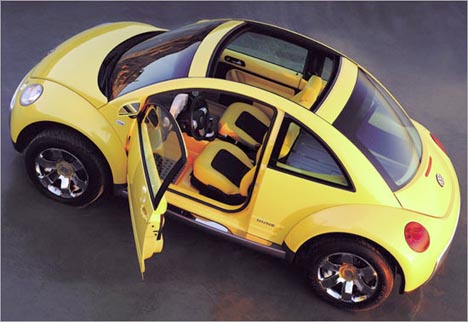
VW
Press Release
1/9/00
It was in 1992 that the Volkswagen
Design Studio in Simi Valley, California, began to draft out the first sketches
in the New Beetle's development history. Now it falls to California again to
take the process a stage further. At this year's Los Angeles Auto Show
Volkswagen is exhibiting a Beetle study that takes the needs of the
sport-oriented driver specifically into account. It's name ñ how could it be
called anything else ñ is "Dune". With a high-torque
V5 engine driving all
four wheels, this very special New Beetle can take you beyond where the road
comes to an end for the conventional on-road automobile. Let your motto be:
ëlive it wild, but stay safe!'
Away from the areas of life symbolized by
the business suit and the hardtop road, an automobile has to show what it's made
of. Dune has been designed to do just that. Its visual clues and technical
features are not just a new interpretation of an old off-road theme.
Volkswagen's designers have also given Dune a totally durable but refreshingly
styled interior. In this setting it's aluminum, high-quality plastics and tough
leather that rule.
The transparent, detachable center section of this
off-road Beetle's roof may look more seagoing than cross-country in style, but
it certainly sets it well apart from every other vehicle in a segment that lies
somewhere between the pure roadgoing vehicle and the off-roader.
The
Body
The airy, versatile roof is a notable feature of the Dune. The
soft top's plastic material allows the light to pass and bathes the interior in
a warm yellow glow, giving you a feeling of sailing in the sun when the roof is
up. When it is open, the Dune creates a very special kind of open-air feeling,
which passengers can enjoy under a blue sky without any drafts of air to disturb
them.
The soft top weighs very little and, with its well-designed
mechanism, is therefore easy to open and close. Two locking fasteners can be
released in a moment; it is then pushed together across the four aluminum struts
that can be seen from the outside and placed in the trunk, where it occupies
very little space.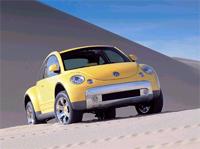
The basic shape of the New Beetle, which has received
three American design awards, has for evident reasons not been changed. The
modifications start where a vehicle that's designed to operate away from the
main highways needs to have different functions. At the front, the underride
guard combined with the radiator grill is an obvious new feature. Made of
aluminum, it acts as a very substantial bumper but none the less remains true to
the New Beetle's typical design language. Because of the space it occupies in
the front air dam, the flashing turn indicators have had to be repositioned: for
the Dune, they are now circular and located next to the headlamps but farther
away from the body sides, where they harmonize well with the central Volkswagen
badge in the hood.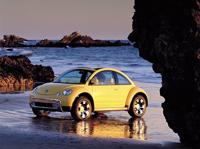
At the rear the center section of the bumper is also
made of aluminum to match the corresponding element at the front. To emphasize
the Dune's sporting character the exhaust emission control system has two
stainless steel tailpipes, and the rear lamps are of clear-glass
design.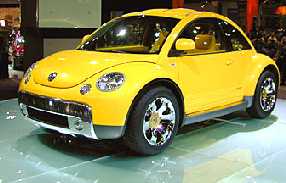
Seen from the side, the Dune's six-spoke, 18-inch alloy wheels
with special 235/60 R 18 tires are a striking feature. By way of comparison: the
standard New Beetle is supplied with 205/55 R 16 tires. Body side protection is
highly functional: two protective strips in the door area, wheel arch liners
that extend round to the outside of the fenders and massive side sills. These
are shaped to protect the underside of the outer body edges effectively when
driving off-road.
The Interior
An automobile conceived
specifically for the enthusiastic leisure user has to be as practical as
possible. Any other concept would be restrictive and defeat the object of
unlimited pleasure. A diver, for instance, doesn't want the car's trunk to be
lined with fabric. Moisture and dirt would soon spoil its appearance. The Dune
leisure concept car is therefore trimmed and finished inside with its
challenging areas of operation in mind.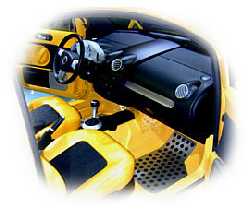
This is why it's logical to start
at the back instead of the front when making a closer examination of the Dune.
The trunk is a major element in its sheer versatility: strongly built but
attractive, the complete load platform is lined with aluminum. This metal was
chosen to make the trunk suitable for a wide variety of purposes and keep it
resistant to dirt and moisture. Front-to-rear aluminum strips retain such items
as air bottles or the diver's Neoprene suit securely. The side panels are
trimmed with a black leather chosen for its durability.
The interior
designers have also paneled the rear seat backs with aluminum sheet. When the
seats are folded, this yields a large, uninterrupted load surface. The Dune's
basic concept is that of a 2 + 2-seater, according to the theory that such
vehicles are nearly always occupied by two people who need all the space that
the variable load area can provide for the equipment they want to carry with
them. But if the two back seats are in use, the passengers' comfort and safety
are also assured: the integral seat head restraints can be pulled out as far as
necessary, and there is even a cold-store box next to the seat.
The
complete floor between the rear seats and the front firewall is covered with a
high-quality, durable synthetic material in Sunrise Yellow. The same color is
used for part of the leather upholstery, the trim and the complete paint finish.
For the footwell areas that may have to stand up to rough treatment, Volkswagen
has installed aluminum plates. Black rubber studs prevent them from slipping.
The contrast between the special Sunrise Yellow and Black elements of the color
scheme is continued on the front seats and in the door trims, which have been
redesigned starting from the center sections. Both the front and back seats use
a non-slip black woven material for their center panels; the outer sections and
sides are in Sunrise Yellow, the seat backs in Black. If sand blown by the wind
or a particularly big wave should accidentally reach the Dune's interior, it can
be easily be cleaned and restored to its original attractive
condition.
The Instruments
The Dune concept study differs
here too in a number of significant ways from the standard New Beetle. The new
central instrument is a striking example of this. Whereas the New Beetle has a
single circular dial containing information on all the principal functions, the
Dune uses three elements. A new navigation system is prominently placed in the
center. It is a compass of above-average intelligence that will lead you
reliably back to civilization if you should happen to stray too far off the
beaten track. Two additional displays in this instrument indicate the body's
roll and tilt angles. The outer dials are a revolution counter at the left and a
speedometer at the right. Like the translucent roof, the instruments are framed
by a plastic surround that allows the light to pass through. It prevents
unwanted reflections but casts a pleasantly soft light on the instruments during
the day.
Aluminum is the main material used for the controls and
functional design elements. The restyled ventilation outlets are made from this
gleaming metal as are the surrounds for the treble and bass radio loudspeakers,
the modified door handles and window lift backplates, the gear shift knob and
the handbrake lever, to mention only the more important items.
The
Technical Features
As mentioned above, the concept car is powered by
a 2.3-liter V5 engine; when used in other Volkswagen models this engine has had
a quoted power output of 150hp. Power is transmitted through a six-speed
manual-shift gearbox to Volkswagen's familiar 4Motion four-wheel
drive.
The Dune's driver can vary the ride height of the car's air
suspension to suit the terrain. With three programmable stages, the suspension
has a total height adjustment range of 120 millimeters (4.72 inches).
In
view of the extensive changes made to its running gear and body, the Dune
concept car differs from the standard New Beetle in all its overall dimensions.
To ensure good off-road properties, the already short front body overhang has
been reduced again slightly. This makes the complete car almost four centimeters
shorter. The opposite situation applies to the width and height: At the lowest
suspension ride height setting, the height goes up by 62 millimeters (2.4
inches). The size 235 tires and the modified fenders which they need have had
the effect of increasing the Dune's width by 101 millimeters (4 inches).